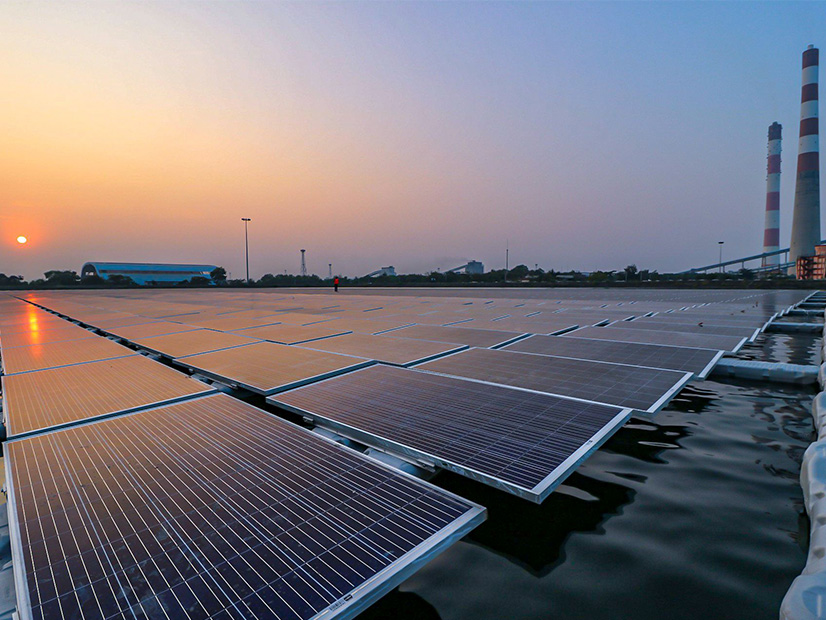
A new joint venture that plans to put floating solar on irrigation ponds and reservoirs in Massachusetts has local environmentalists concerned.
Ciel et Terre subsidiary Laketricity and BlueWave Solar formed the joint venture in August to forge new places to develop renewable energy.
BlueWave says floating solar arrays are part of the solution to save forested land in the state, which serves as an important carbon sink in the race to reduce emissions. Floating solar photovoltaics on the more than 24,000 human-made U.S. reservoirs and water treatment plants could generate about 10% of the nation’s annual electricity production and save 2.1 million hectares of land, according to the National Renewable Energy Laboratory.
“We are not looking at bodies of water where there is a lot of fishing or recreation,” George Wissing, senior project developer for Laketricity, told NetZero Insider. “And we are not taking down any trees.”
Environmentalists and biologists in Massachusetts have raised concerns about building solar panels on forested or undeveloped land in the state, and some environmental groups say more information is still needed about the ecological impact of floating solar panels.
“I don’t know why they don’t just pivot to brownfields or the built environment,” Meg Sheehan, a public interest environmental lawyer, told NetZero Insider. Sheehan previously worked as an assistant attorney general in Massachusetts and as a staff attorney for the Massachusetts Water Resources Authority.
The Department of Energy Resources (DOER) should “keep their hands off public water resources,” she said.
The Solar Massachusetts Renewable Target program (SMART), which provides incentives to encourage solar development, includes floating solar with an additional 3 cents/kWh of energy generated.
SMART gives solar developers subsidies for developing on public resources, Sheehan said.
BlueWave works on “dual-use” solar projects in Massachusetts, where solar panels are placed over agricultural fields.
Another company, Pine Ridge Renewables, is developing solar panels over cranberry bogs in Carver to create an additional income stream for growers. However, the projects are still experimental, and the impact on cranberry growth has yet to be seen by both farmers and developers, Wissing said.
Challenges for Floating Solar
Floating solar technology is new, and people still have to “get used to the idea of it,” Wissing said.
The solar panels are placed on floating mounted bases that snap together, and the array is anchored to the bottom of the body of water as well as the shore. Wissing says communities have been concerned that the materials used for the structure, such as silicone, glass and metal, will affect drinking water. But the materials have been certified as drinking-water safe in the U.K., he said.
BlueWave and Laketricity worked with the Massachusetts Department of Environmental Protection to establish a surface-area coverage of no more than 50% to allow enough sunlight to filter through to the ecosystem below. With a portion of the surface area covered, the panels will also prevent some evaporation from reservoirs, protecting the water source, Wissing said.
Anchoring floating solar structures to the bottom of a body of water can be more challenging than ground-mounted solar, according to Wissing. Water levels change over time, so the poles and anchors must be flexible to allow for the changes.
In a body of water like a cranberry bog, the changes in water level are predictable, depending on when the growers flood the bog for irrigation, Wissing said. For drinking water reservoirs, the changes may not be as predictable, he added.
Environmentalist Janet Sinclair has raised concerns about bird strikes on the panels because they might mistake the infrastructure for water.
“Migrating birds who have followed one path for years might get confused and fly into panels,” which kills the birds, Sinclair said.
The floating material that holds the solar panels looks like a sidewalk from the sky, according to Wissing, who added that there are clear walkways delineating the array.
Government agencies that subsidize floating solar projects in human-made bodies of water “act as though these ponds don’t have their own ecological value,” Sinclair said. “This is just another taste of not looking before we leap.”
Floating solar has already been deployed at scale in Japan, a country that faces similar space issues as Massachusetts in siting renewable energy projects.
“If we are going to build out [renewable energy] at the capacity we need, floating solar in human-made bodies of water is an important part of the solution,” Mike Marsch, principal and head of solar development at BlueWave, told NetZero Insider. “We are a very environmentally focused developer, and we are doing it for the right reasons.”
Note: This article was updated on Sept. 24, 2021, to correct the developer of solar over the cranberry bogs in Carver as Pine Ridge Renewables.
